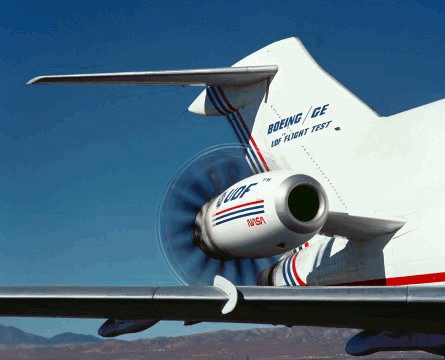John Green is chairman of the science and technology sub-group within the Royal Aeronautical Society's Greener By Design sustainable aviation effort.
He is also a former chief executive of the UK-based windtunnel test centre Aircraft Research Association (ARA) and as such has followed the vicissitudes of the counter-rotating open rotor, dominated by the well-documented oil price hikes of the late 1970s.
While General Electric and Pratt & Whitney were more advanced in their respective development of open rotor concepts, the UK too was well down this road before the drop in oil prices kicked the design upstart under the rug.
Green says that Rolls-Royce joined the fray in the 1980s, shortly after oil peaked at $100/barrel at today's prices, holding serious talks with Boeing about an alternative engine offering for the 7J7 when it seemed certain that the future of aviation was propeller-shaped.
 |
|---|
© The Flight Collection |
"Because Boeing had, by then, adapted its own transonic windtunnel to enable acoustic testing for propeller-driven projects, it was decided that, if Rolls-Royce were to offer an engine, the UK had to develop a windtunnel capability for propeller performance and noise testing at high speeds," he says.
The UK Department of Trade and Industry, ARA, BAe, Dowty Rotol and R-R all agreed, therefore, to co-fund the new capability at ARA - a substantial investment.
It was a two-pronged approach. High-pressure air motors were developed to drive small scale - typically 355mm (14in)-diameter propellers, both single rotation and counter rotating, installed on windtunnel models. In recent times the propeller installation testing of the Airbus A400M was done at ARA using this facility. In parallel, two 440kW electric motors were obtained that could drive large diameter propellers, again either single rotation or counter rotating. By the mid-1980s, the first fruits included tests on a 90mm-diameter, single rotation propeller made from carbonfibre. "We learnt a lot from the first test conducted as the blade pulled itself off under centrifugal force, disintegrating into a million pieces and showering the windtunnel with carbonfibre splinters," says Green.
"When notes were exchanged with Boeing many years later, they admitted to having similar teething troubles but, because their blades were titanium, there was rather more damage to the tunnel test section."
In 1989 the counter-rotating version of the large rig, Rolls-Royce Rig 140, was tested to gather both performance and acoustic data. It was a complex and successful programme, but by then, with oil prices at a third of their 1980 levels, it was clear that Boeing was not going ahead with the 7J7.
R-R adapted the rig to test its quieter, cowled, contra-rotating aft fan, the RB529 UHB (ultra-high-bypass) project. In this form, as Rig 141, it was tested in 1990 in the German/Dutch DNW low-speed windtunnel in the Netherlands, a mock-up of the RB529 having already been seen at the 1986 Farnborough air show. The quietened beast was seen as the next best thing in terms of fuel efficiency despite greater weight and drag penalties.
The world has changed since the singular focus of 1980s oil prices but, as Green notes, with the twilight era of easy oil and the growing demand from the expansion of the economies of China and India set to drive prices upwards again, coupled with increasing environmental pressures, the fuel-efficient open rotor looks set to make a comeback.
Rig 140 has morphed into the 710mm-diameter Rig 145 with contra-rotating propellers, has been tested at low speeds in the Netherlands and is now back in the UK for noise and performance tests at high speed at ARA in Bedford, adapted to take account of the advanced engineering know-how of the early 21st century.
Speaking at last year's Royal Aeronautical Society's Greener By Design conference about the engine maker's design and validation efforts, R-R senior project engineer Dr Mark Taylor reported that initial results from the low-speed acoustic test campaign were not only in line with expectations, but represented "a very big step" in its open rotor programme.
"Based on this new and innovative technology, Rolls-Royce believes a quiet and efficient open rotor engine is realisable," Taylor told the conference.
Source: Flight International



















